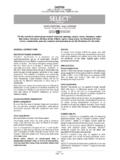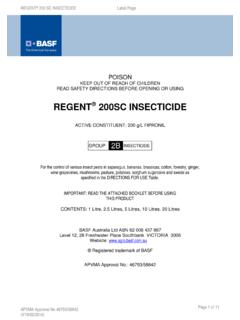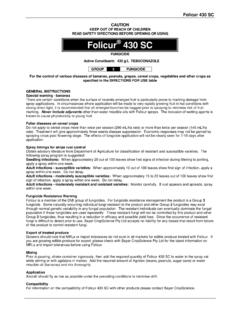Transcription of 20 LITRES - HerbiGuide
1 CAUTIONKEEP OUT OF REACH OF CHILDRENREAD SAFETY DIRECTIONS BEFORE OPENING OR USINGACTIVE CONSTITUENT: 250 g/L AZOXYSTROBINFor the control of various diseases of Almonds, Avocados, Beans, Brassicas, Citrus, Cucurbits, Grapes, Lettuce, Mangoes, Potatoes, Tomatoes, Passionfruit, Poppies and other crops as per the Directions for UseIMPORTANT: Read this booklet before use20 LITRESS yngenta Australia Pty Ltd Level 1, 2-4 Lyonpark Road, Macquarie Park NSW 2113In a transport emergency dial 000, Police or Fire BrigadeFor specialist advice in an emergency only, call 1800 033 111 (24 hours)APVMA Approval No: 58340/528960414L179367 AUST/4S 23 DIRECTIONS FOR USER estraintDO NOT apply by air, except on potatoesTREE AND VINE CROPSRateIn the following table Tree and Vine Crops, all rates given are for dilute spraying.
2 For concentrate spraying, refer to the Application (Colletotrichum acutatum)Stem End Rot, AnthracnoseBrown Spot (Alternaria sp.),Black Spot (Guignardia citricarpa) L/ha80 mL/100 L40 mL/100 LWHP4 weeks7 days4 weeks Critical CommentsFor all uses in the table Tree and Vine Crops: Apply by dilute or concentrate spraying equipment. Apply the same total amount of product to the target crop whether applying this product by dilute or concentrate spraying applying AMISTAR 250 SC through low volume application equipment, DO NOT use a concentrate factor greater than 4X. In these cases adequate coverage of all plant surfaces is still required to achieve control of using orchard airblast/mister sprayer applying sufficient water to obtain uniform coverage.
3 May be applied as a Dilute or Concentrate with sprays of other chemical Application: Water volumes typically range from 1800 to 2000 Application: Apply in 800 to 1000 as part of an anthracnose disease management NOT apply more than 3 applications per best results commence the disease control program with an approved fungicide from an alternative chemical group, then apply 1 application of AMISTAR 250 SC during early fruit set. Follow with applications of an approved fungicide from a different chemical group. Apply 2 final applications of AMISTAR 250 SC at 14 to 28 day intervals with the final spray applied 7 days prior to thorough spray NOT use AMISTAR 250 SC NOT apply more than 3 applications of AMISTAR 250 SC per season.
4 DO NOT start the disease control program with AMISTAR 250 Resistance best results apply 1 to 2 applications of AMISTAR 250 SC after copper fungicides, at no less than 14 day intervals. Follow with applications of an approved fungicide from a different chemical group. Ensure thorough spray NOT use AMISTAR 250 SC NOT apply more than 2 applications of AMISTAR 250 SC per NOT start the disease control program with AMISTAR 250 Critical CommentsGrapesTable,wine, driedMangoesPowdery Mildew (Uncinular necator),DownyMildew (Plasmopara viticola),Botrytis Bunch Rot (Botrytis cinerea)Stem End Rot, Anthracnose75 to 100 mL/100 L80 mL/100 L14 days3 daysThis use is subject to a CropLife Fungicide Resistance Management in a sufficient volume of water to achieve thorough coverage of all foliage and fruit.
5 The volume of water required to achieve this will depend on the stage of vine growth and thorough coverage. Adjust spray nozzles to direct spray droplets to the canopy present. Apply the higher rate of application in the following circumstances:1. Where humid conditions favour Powdery Mildew infection, particularly on susceptible varieties2. At the start of the season when there has been a heavy carry over of Powdery Mildew infection (flag shoots are present)Apply 2 consecutive applications at 10 to 16 day intervals at any time between early shoot growth and 14 days before harvest. Use the recommended shorter interval during periods when climatic conditions are favourable for disease infection. Botrytis Bunch RotAMISTAR 250 SC must not be used alone for Botrytis control at critical times such as 80 to 100% capfall and pre-harvest.
6 It must be tank mixed with or substituted by a specific botryticide at these critical times. When AMISTAR 250 SC is used in a seasonal spray program it will provide control of Botrytis additional to that of specific botryticides such as Bravo . DO NOT use AMISTAR 250 SC NOT apply more than 2 applications of AMISTAR 250 SC per crop in 1 NOT use AMISTAR 250 SC for disease control in grapevine Resistance best results apply 1 to 2 applications of AMISTAR 250 SC at flowering and early fruit set, at no less than 14 day intervals. Follow with applications of an approved fungicide from a different chemical group. Further applications of AMISTAR 250 SC may be applied at 21 days and 3 to 7 days prior to thorough spray NOT use AMISTAR 250 SC NOT apply more than 3 applications of AMISTAR 250 SC per season.
7 DO NOT start the disease control program with AMISTAR 250 Resistance Critical Comments Critical Comments Critical CommentsPassionfruitPistachioGarlic,Shal lots,Spring OnionsBeans Brassica Leafy VegetablesBrassica VegetablesCucurbitsHorseradishAlternaria , CladosporiumAlternaria Late Blight (Alternaria alternata), Anthracnose (Colletotrichumspp.), Botryosphaeriadothidea(Dothiorella dominicana)Suppression ofWhite Rot (Sclerotinium cepivorum)Suppression of Sclerotinia Rot(Sclerotinia spp.)AlternariaLeaf SpotWhite Blister Rust (Albugo candida), Sclerotinia RotPowdery Mildew(Sphaerothecafuliginea),Downy Mildew(Pseudo-peronospora cubensis)Gummy Stem Blight(Didymella bryoniae)White Blister Rust(Albugo candida), Downy Mildew80 mL/ 100 L 1 L/ha800 mL/ha500 to 600 mL/haor50 to 60 mL/ 100 L400 mL/ha500 mL/ha80 to 120 mL/100 L120 mL/100 L 600 mL/ha1 day4 weeks7 days-7 days1 day7 daysThis use is subject to a CropLife Fungicide Resistance Management best results apply 2 to 3 applications of AMISTAR 250 SC at 14 day intervals over flowering.
8 Follow with applications of an approved fungicide from a different chemical group. Apply a further 1 to 2 applications of AMISTAR 250 SC finishing 1 day prior to thorough spray NOT use AMISTAR 250 SC NOT exceed 5 applications of AMISTAR 250 SC per crop. DO NOT start the disease control program with AMISTAR 250 Resistance Management. Apply using orchard airblast/mister sprayer applying sufficient water to obtain uniform coverage. May be applied as a Dilute or Concentrate spray. Alternate with sprays of other chemical Application: Water volumes typically range from 1800 to 2000 Application: Apply in 800 to 1000 : Apply during nut : Apply when conditions favour disease NOT apply more than 3 applications per at the first sign of disease or preferably preventatively when a disease predictive assessment shows conditions favourable to disease development.
9 Apply a program of 2 to 3 consecutive sprays of product at 7 to 14 day intervals. Use the shorter interval when weather conditions favour disease infection. Apply in sufficient water volume using ground boom spray equipment or equivalent only as a foliar spray. Good coverage of foliage is essential. Use a higher volume in dense or well grown crops. DO NOT apply more than 3 applications per crop per in sufficient volume of water to achieve thorough coverage of all foliage. Use the higher rates when climatic conditions are humid and mild which favours disease Interval: Apply a maximum of 2 consecutive applications at 7 to 14 day intervals commencing soon after planting and continuing up to crop maturity. Use the recommended shorter interval under humid weather conditions that are favourable for disease infection or where there is rapid vegetative growth during the early part of the crop cycle.
10 DO NOT apply more than 3 applications per cropSee Resistance in sufficient water to ensure through coverage of all plant parts. Repeat application(s) 7 to 14 days later depending on severity of : Add a non-ionic surfactant to the spray mix. DO NOT apply more than 2 applications per cropSee Resistance use is subject to a CropLife Fungicide Resistance Management applications should be applied at 7 to 14 day intervals, commencing soon after transplanting and continuing up to fruit maturity. Use the recommended shorter application interval in the following circumstances:1. Under humid weather conditions which are favourable for Powdery Mildew, Downy Mildew or Gummy Stem Blight infection2. When there is rapid vegetative growth during the early part of the crop cycleApply the higher rate when climatic conditions favour powdery or Downy Mildew infection and in crops with large canopies.
















